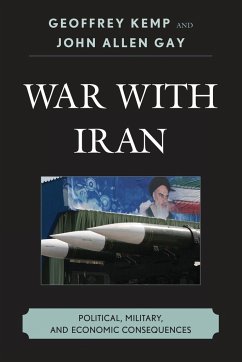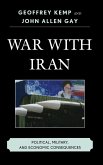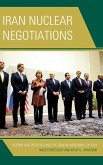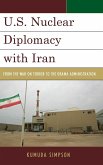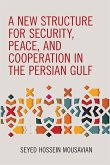- Broschiertes Buch
- Merkliste
- Auf die Merkliste
- Bewerten Bewerten
- Teilen
- Produkt teilen
- Produkterinnerung
- Produkterinnerung
War With Iran: Political, Military and Economic Consequences provides readers both a history of Iran’s relationship with the West and an expert’s estimation of what the political, human and financial costs of full-scale war with Iran might be.
Andere Kunden interessierten sich auch für
![War With Iran War With Iran]() Geoffrey KempWar With Iran135,99 €
Geoffrey KempWar With Iran135,99 €![Iran Divided Iran Divided]() Shireen T. HunterIran Divided132,99 €
Shireen T. HunterIran Divided132,99 €![Iran Nuclear Negotiations Iran Nuclear Negotiations]() Nader EntessarIran Nuclear Negotiations113,99 €
Nader EntessarIran Nuclear Negotiations113,99 €![Iran Divided Iran Divided]() Shireen T. HunterIran Divided57,99 €
Shireen T. HunterIran Divided57,99 €![U.S. Nuclear Diplomacy with Iran U.S. Nuclear Diplomacy with Iran]() Kumuda SimpsonU.S. Nuclear Diplomacy with Iran107,99 €
Kumuda SimpsonU.S. Nuclear Diplomacy with Iran107,99 €![Political Identities and Popular Uprisings in the Middle East Political Identities and Popular Uprisings in the Middle East]() Political Identities and Popular Uprisings in the Middle East172,99 €
Political Identities and Popular Uprisings in the Middle East172,99 €![New Structure for Security, Peace, and Cooperation in the Persian Gulf New Structure for Security, Peace, and Cooperation in the Persian Gulf]() Seyed Hossein MousavianNew Structure for Security, Peace, and Cooperation in the Persian Gulf44,99 €
Seyed Hossein MousavianNew Structure for Security, Peace, and Cooperation in the Persian Gulf44,99 €-
-
-
War With Iran: Political, Military and Economic Consequences provides readers both a history of Iran’s relationship with the West and an expert’s estimation of what the political, human and financial costs of full-scale war with Iran might be.
Produktdetails
- Produktdetails
- Verlag: Rowman & Littlefield Publishers
- Seitenzahl: 266
- Erscheinungstermin: 19. Februar 2013
- Englisch
- Abmessung: 229mm x 152mm x 14mm
- Gewicht: 390g
- ISBN-13: 9781442221970
- ISBN-10: 1442221976
- Artikelnr.: 37151680
- Herstellerkennzeichnung
- Libri GmbH
- Europaallee 1
- 36244 Bad Hersfeld
- gpsr@libri.de
- Verlag: Rowman & Littlefield Publishers
- Seitenzahl: 266
- Erscheinungstermin: 19. Februar 2013
- Englisch
- Abmessung: 229mm x 152mm x 14mm
- Gewicht: 390g
- ISBN-13: 9781442221970
- ISBN-10: 1442221976
- Artikelnr.: 37151680
- Herstellerkennzeichnung
- Libri GmbH
- Europaallee 1
- 36244 Bad Hersfeld
- gpsr@libri.de
Geoffrey Kemp is the director of Regional Strategic Programs at the Nixon Center in Washington, D.C. He served in the White House under Ronald Reagan, as special assistant to the president for National Security Affairs and senior director for Near East and South Asian Affairs on the National Security Council staff. Prior to his current position, he directed the Middle East Arms Control Project at the Carnegie Endowment for International Peace. He is coauthor of Strategic Geography and the Changing Middle East (Carnegie).
Acknowledgements
Prologue
Introduction
Iran's Nuclear Program
Chapter 1: Positions of Primary Actors
Iran
Key Opponents to Iran's Nuclear Program
The United States
Direct Relations
Israel
Global Opponents
Chapter 2: Choosing to Attack
Context for a Strike
Surprise Attack
War Escalates
Response to Nuclear Provocation
Merits and Risks of a Strike
Expert Voices
Political Voices
Chapter 3: How an Attack Might Work
Targeting
An Israeli Strike
The Central Route: Overflying Iraq
Logistics of an Israeli Strike
An American Strike
Bunker Busting
Iranian Air Defenses
Follow-On Strikes
Impact on Iran's Nuclear Program
Alternative Means of Destruction
Sabotage
Commando Raid
Chapter 4: Iran's Retaliation
Lebanese Hezbollah
Israeli Natural Gas Sites
Iraq and Afghanistan
General Terrorism
The Strait of Hormuz
Insurgency in the Gulf
The Missile Threat
Other Iranian Threats to Oil
Chapter 5: Evolving Crisis, Challenging Exit
Mass Retaliation
Nonretaliation
Middle Paths
American Response and Cyclical Violence
Chapter 6: Regional Oil
Gulf Oil: Iran's Role
Oil Prices and Iran's Economy
Chapter 7: Oil and War
Recent History
Impact of a Military Strike on Iran
Impact of an Attack on Iranian Oil Facilities
Iran's Options Against Regional Oil
Action in the Strait of Hormuz
Attacking Arab Oil Facilities
Mobilizing the Saudi Shia Population
Use of Weapons of Mass Destruction
Iraq and Azerbaijan
Chapter 8: Preparing for Oil Disruptions
Mitigation
Rerouting Oil Flows
Excess Capacity
Assurance
Preparation
Expanding Reserves
Pipeline Preparation
Removal of Bottlenecks
Preparing to Reduce Demand
Readying the Refinery Network
"Pre-Assuring" Investors
Chapter 9: Economic Consequences
Wider Economic Factors
Growth Patterns and Oil Markets
Oil Price Increases and Supply Interruption
Oil Price Increases and Economic Recovery
Threats to the Dollar
Alternatives to the Dollar?
However
Impacts in the Middle East
Regional Conflicts
American Trade
The Impact of the Sanctions
Conclusions
Chapter 10: Conclusions: The Challenge of Getting Out, the Costs of Staying
Home
Exit Strategy for War with Iran
Internal Political Impacts
The Cost of Inaction
Conclusions
Appendices
Bibliography
Prologue
Introduction
Iran's Nuclear Program
Chapter 1: Positions of Primary Actors
Iran
Key Opponents to Iran's Nuclear Program
The United States
Direct Relations
Israel
Global Opponents
Chapter 2: Choosing to Attack
Context for a Strike
Surprise Attack
War Escalates
Response to Nuclear Provocation
Merits and Risks of a Strike
Expert Voices
Political Voices
Chapter 3: How an Attack Might Work
Targeting
An Israeli Strike
The Central Route: Overflying Iraq
Logistics of an Israeli Strike
An American Strike
Bunker Busting
Iranian Air Defenses
Follow-On Strikes
Impact on Iran's Nuclear Program
Alternative Means of Destruction
Sabotage
Commando Raid
Chapter 4: Iran's Retaliation
Lebanese Hezbollah
Israeli Natural Gas Sites
Iraq and Afghanistan
General Terrorism
The Strait of Hormuz
Insurgency in the Gulf
The Missile Threat
Other Iranian Threats to Oil
Chapter 5: Evolving Crisis, Challenging Exit
Mass Retaliation
Nonretaliation
Middle Paths
American Response and Cyclical Violence
Chapter 6: Regional Oil
Gulf Oil: Iran's Role
Oil Prices and Iran's Economy
Chapter 7: Oil and War
Recent History
Impact of a Military Strike on Iran
Impact of an Attack on Iranian Oil Facilities
Iran's Options Against Regional Oil
Action in the Strait of Hormuz
Attacking Arab Oil Facilities
Mobilizing the Saudi Shia Population
Use of Weapons of Mass Destruction
Iraq and Azerbaijan
Chapter 8: Preparing for Oil Disruptions
Mitigation
Rerouting Oil Flows
Excess Capacity
Assurance
Preparation
Expanding Reserves
Pipeline Preparation
Removal of Bottlenecks
Preparing to Reduce Demand
Readying the Refinery Network
"Pre-Assuring" Investors
Chapter 9: Economic Consequences
Wider Economic Factors
Growth Patterns and Oil Markets
Oil Price Increases and Supply Interruption
Oil Price Increases and Economic Recovery
Threats to the Dollar
Alternatives to the Dollar?
However
Impacts in the Middle East
Regional Conflicts
American Trade
The Impact of the Sanctions
Conclusions
Chapter 10: Conclusions: The Challenge of Getting Out, the Costs of Staying
Home
Exit Strategy for War with Iran
Internal Political Impacts
The Cost of Inaction
Conclusions
Appendices
Bibliography
Acknowledgements
Prologue
Introduction
Iran's Nuclear Program
Chapter 1: Positions of Primary Actors
Iran
Key Opponents to Iran's Nuclear Program
The United States
Direct Relations
Israel
Global Opponents
Chapter 2: Choosing to Attack
Context for a Strike
Surprise Attack
War Escalates
Response to Nuclear Provocation
Merits and Risks of a Strike
Expert Voices
Political Voices
Chapter 3: How an Attack Might Work
Targeting
An Israeli Strike
The Central Route: Overflying Iraq
Logistics of an Israeli Strike
An American Strike
Bunker Busting
Iranian Air Defenses
Follow-On Strikes
Impact on Iran's Nuclear Program
Alternative Means of Destruction
Sabotage
Commando Raid
Chapter 4: Iran's Retaliation
Lebanese Hezbollah
Israeli Natural Gas Sites
Iraq and Afghanistan
General Terrorism
The Strait of Hormuz
Insurgency in the Gulf
The Missile Threat
Other Iranian Threats to Oil
Chapter 5: Evolving Crisis, Challenging Exit
Mass Retaliation
Nonretaliation
Middle Paths
American Response and Cyclical Violence
Chapter 6: Regional Oil
Gulf Oil: Iran's Role
Oil Prices and Iran's Economy
Chapter 7: Oil and War
Recent History
Impact of a Military Strike on Iran
Impact of an Attack on Iranian Oil Facilities
Iran's Options Against Regional Oil
Action in the Strait of Hormuz
Attacking Arab Oil Facilities
Mobilizing the Saudi Shia Population
Use of Weapons of Mass Destruction
Iraq and Azerbaijan
Chapter 8: Preparing for Oil Disruptions
Mitigation
Rerouting Oil Flows
Excess Capacity
Assurance
Preparation
Expanding Reserves
Pipeline Preparation
Removal of Bottlenecks
Preparing to Reduce Demand
Readying the Refinery Network
"Pre-Assuring" Investors
Chapter 9: Economic Consequences
Wider Economic Factors
Growth Patterns and Oil Markets
Oil Price Increases and Supply Interruption
Oil Price Increases and Economic Recovery
Threats to the Dollar
Alternatives to the Dollar?
However
Impacts in the Middle East
Regional Conflicts
American Trade
The Impact of the Sanctions
Conclusions
Chapter 10: Conclusions: The Challenge of Getting Out, the Costs of Staying
Home
Exit Strategy for War with Iran
Internal Political Impacts
The Cost of Inaction
Conclusions
Appendices
Bibliography
Prologue
Introduction
Iran's Nuclear Program
Chapter 1: Positions of Primary Actors
Iran
Key Opponents to Iran's Nuclear Program
The United States
Direct Relations
Israel
Global Opponents
Chapter 2: Choosing to Attack
Context for a Strike
Surprise Attack
War Escalates
Response to Nuclear Provocation
Merits and Risks of a Strike
Expert Voices
Political Voices
Chapter 3: How an Attack Might Work
Targeting
An Israeli Strike
The Central Route: Overflying Iraq
Logistics of an Israeli Strike
An American Strike
Bunker Busting
Iranian Air Defenses
Follow-On Strikes
Impact on Iran's Nuclear Program
Alternative Means of Destruction
Sabotage
Commando Raid
Chapter 4: Iran's Retaliation
Lebanese Hezbollah
Israeli Natural Gas Sites
Iraq and Afghanistan
General Terrorism
The Strait of Hormuz
Insurgency in the Gulf
The Missile Threat
Other Iranian Threats to Oil
Chapter 5: Evolving Crisis, Challenging Exit
Mass Retaliation
Nonretaliation
Middle Paths
American Response and Cyclical Violence
Chapter 6: Regional Oil
Gulf Oil: Iran's Role
Oil Prices and Iran's Economy
Chapter 7: Oil and War
Recent History
Impact of a Military Strike on Iran
Impact of an Attack on Iranian Oil Facilities
Iran's Options Against Regional Oil
Action in the Strait of Hormuz
Attacking Arab Oil Facilities
Mobilizing the Saudi Shia Population
Use of Weapons of Mass Destruction
Iraq and Azerbaijan
Chapter 8: Preparing for Oil Disruptions
Mitigation
Rerouting Oil Flows
Excess Capacity
Assurance
Preparation
Expanding Reserves
Pipeline Preparation
Removal of Bottlenecks
Preparing to Reduce Demand
Readying the Refinery Network
"Pre-Assuring" Investors
Chapter 9: Economic Consequences
Wider Economic Factors
Growth Patterns and Oil Markets
Oil Price Increases and Supply Interruption
Oil Price Increases and Economic Recovery
Threats to the Dollar
Alternatives to the Dollar?
However
Impacts in the Middle East
Regional Conflicts
American Trade
The Impact of the Sanctions
Conclusions
Chapter 10: Conclusions: The Challenge of Getting Out, the Costs of Staying
Home
Exit Strategy for War with Iran
Internal Political Impacts
The Cost of Inaction
Conclusions
Appendices
Bibliography

